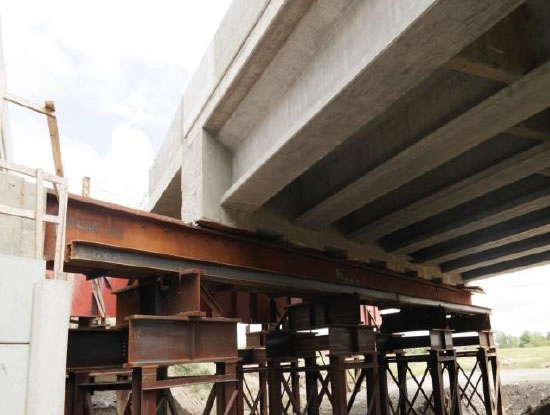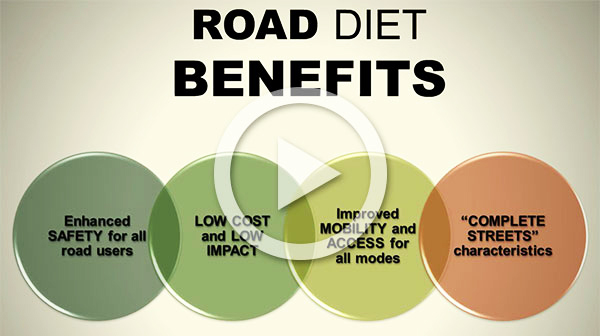October 8, 2015
Innovation of the Month: Road Diets
Increased safety and congestion relief on roads are high-priority national goals. Innovative roadway reconfigurations such as road diets can help achieve these goals on mixed-use streets by reducing vehicle speeds and freeing space for uses such as bike lanes, transit stops and parking.
Road diets offer several benefits:
- Safety–Studies show a 19 to 47 percent reduction in overall crashes when a road diet is installed on a four-lane undivided road. Road diets can make room for pedestrian refuge islands in the midblock crossing area, where 70 percent of pedestrian fatalities occur.
- Low cost–Road diets make efficient use of the roadway cross-section. The majority are installed on existing pavement within the right-of-way, essentially for the cost of restriping pavement lanes.
- Quality of life–Road diets can make shared spaces more livable and contribute to a community-focused complete streets environment.
Watch the EDC Exchange: Road Diets webcast for a discussion of road diet benefits, applications and success stories.
STIC Meeting Explores Innovation Leadership
Every state has used eight or more innovations promoted by the Every Day Counts initiative, FHWA Administrator Gregory Nadeau said to participants in a national State Transportation Innovation Council video/web conference on October 1. The nation’s 49 STICs play a key role in leading innovation deployment in their states, Nadeau said. “It’s important that we build on the work we’ve done so far to ensure the focus on innovation becomes a permanent part of our transportation culture,” he said. “It’s time to take our efforts to the next level.”
Shailen Bhatt, executive director of the Colorado Department of Transportation, discussed the Colorado STIC’s focus on using innovations such as accelerated bridge construction to drive customer satisfaction. Daniel D’Angelo, deputy chief engineer of the New York State Department of Transportation, talked about the New York STIC’s approach of developing an action plan that includes all EDC innovations and creating synergy through use of multiple innovations on a project.
Arizona Hosts Data-Driven Safety Analysis Peer Exchange
on data-driven safety analysis September 23 and 24 in Phoenix, Arizona. Participants from nine states–including Arizona, Arkansas, California, Colorado, Idaho, Illinois, Nevada, Texas and Wisconsin–shared best practices and lessons learned on implementing systemic approaches to data-driven safety analysis. At the exchange, representatives from each state developed an action plan to implement systemic approaches to data-driven safety analysis over the next year.
View Accelerated Construction on Iowa Bridge
Work is underway on a project to replace the Little Silver Creek Bridge on Iowa 92 in Pottawattamie County. This is the Iowa Department of Transportation’s second accelerated bridge construction project using the modular construction method. The project received an Accelerated Innovation Deployment Demonstration award to use ABC, including prefabricated elements and ultra-high performance concrete connections. Using ABC will cut full road closure time on the project by 90 percent. See the Iowa DOT’s video gallery to view the bridge construction process.
Maryland Leads Planning and Environmental Linkages Study
Transportation professionals from the public and private sectors learned about accelerated bridge construction at a September 19 workshop hosted by the Delaware Department of Transportation and FHWA. Speakers from the New York State and Pennsylvania Departments of Transportation provided an owner’s perspective on ABC projects in their states. Contractors offered an industry view on the same projects.
Ohio Launches Road Diets eLearning Module
The Maryland State Highway Administration and Pennsylvania Department of Transportation initiated a planning and environmental linkages study for the U.S. 219 I-68 to Meyersdale project, with the Maryland agency as the lead. The project to improve roadway linkage, motorist safety and economic development potential on U.S. 219 was on hold from 2007 to June 2015, when Maryland’s governor announced that construction of the I-68/U.S. 219 interchange in Garrett County is a priority. The PEL study will update information collected from previous environmental documents, identify potential alignments and address fiscal constraints.
Innovative Oklahoma Bridges Withstand Flooding
At an event held in conjunction with the September 15 EDC Exchange: GRS-IBS webcast, Kay County, Oklahoma, officials discussed their experience building four geosynthetic reinforced soil-integrated bridge system structures. They reported that the bridges, built over Dry Creek in Blackwell, withstood significant flooding in May and June, highlighting a selling point for more GRS-IBS use in Oklahoma. The meeting was hosted by the Oklahoma Local Technical Assistance Program, Southern Plains Tribal Technical Assistance Program, Oklahoma Department of Transportation and FHWA.
Ohio Ready for First Lateral Bridge Slide
The Ohio Department of Transportation will use slide-in bridge construction for the first time when it removes and replaces a bridge on I-75 over U.S. 6 this weekend. The contractor will begin demolition work Friday evening and start sliding the bridge Saturday evening. During the slide, the Ohio DOT will close U.S. 6, but keep two lanes of I-75 traffic open in both directions. The agency chose the lateral bridge slide method for the project to improve safety and reduce traffic disruption.

Ohio’s first lateral bridge slide is set for this weekend.
Oklahoma Reviews Results of High-Friction Surface Treatment Project
Stakeholders involved in a project to apply high-friction surface treatments on I-44 and I-40 in Oklahoma City, Oklahoma, met September 29 to discuss results and lessons learned. The Oklahoma Department of Transportation used an Accelerated Innovation Deployment Demonstration award on the project, which enabled the department to gain experience using HFST and plan for statewide deployment in safety-critical locations. The Oklahoma DOT will develop a report on project results that will be posted on the AID Demonstration project page.
2015 Interactive Highway Safety Design Model Available
FHWA released version 11.0.0 of the Interactive Highway Safety Design Model, a suite of software analysis tools that support data-driven safety analysis. The software is available for free download at the IHSDM website. To learn about the features of 2015 IHSDM, register for a webinar on October 22 from 2 to 3:30 p.m. ET. Participants are encouraged to register by October 20.



